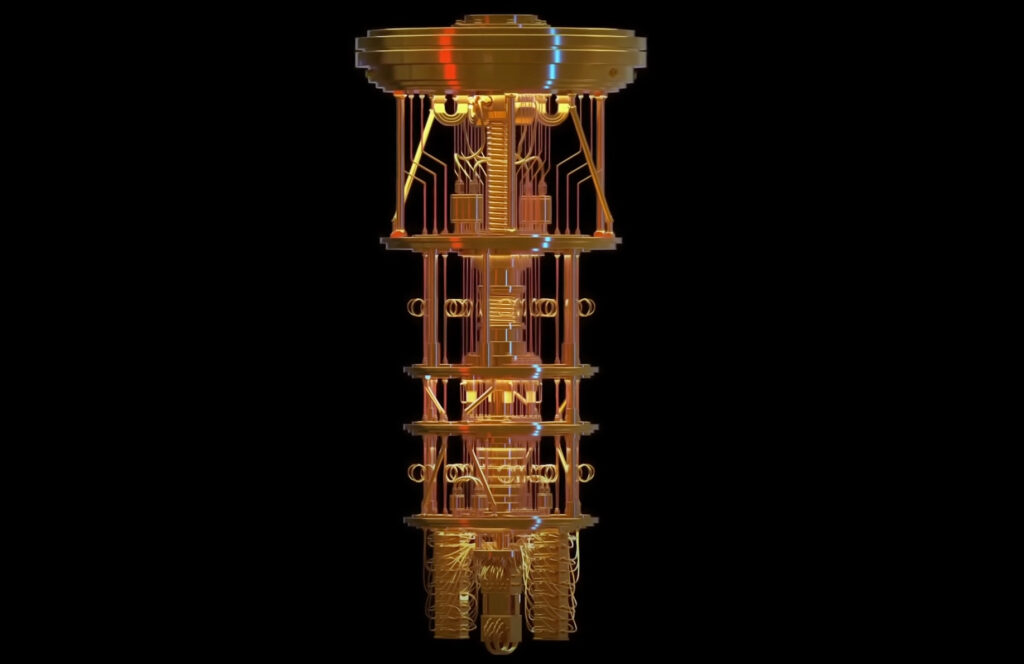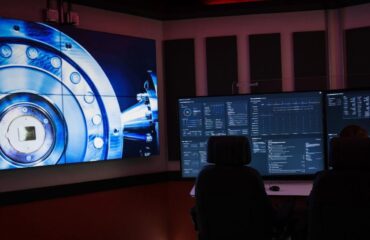
A quantum computer
As The Quantum Record makes an account of the present condition and future direction of human knowledge, we survey some of the latest developments in quantum computing.
Practical applications for quantum computing are becoming real
By James Myers
Quantum computing uses the properties of quantum mechanics to produce computations with far greater speed than the computers we use today. A strong signal of progress in understanding the connection between computing and quantum mechanics, the 2022 Nobel Prize in Physics was awarded for discoveries in “pioneering quantum information science.” The three scientists who were awarded the prize established that particles in an entangled state – which is how the quantum computer’s qubit operates – can affect other particles even at vast distances.
Where will this revolutionary technology take us in the future – or where do we want it to take us? The choice remains, for now, ours to make of it what we will.
Quantum Computers, Explained With Quantum Physics
One Big Step Closer to Interstellar Travel.
“A quantum computer has simulated a wormhole for the first time,” the headlines declared at the beginning of December. The achievement could be a major advance in the human quest to travel faster than the speed of light through interstellar space, and to understand the elusive nature of gravity.

Artist rendering of a wormhole. For objects approaching a wormhole at near the speed of light, time “dilates” or appears to slow and eventually stop.
Wormholes were theorized by Albert Einstein and Nathan Rosen in 1935 to exist within spacetime under the theory of general relativity, although the term “wormhole” was coined by physicists John Wheeler and Charles Misner in 1957. A wormhole can be thought of as a tunnel, or “bridge”, that connects two potentially very distant points in the curving fabric of spacetime.
Although wormholes have never been physically observed, they have featured prominently in many science fiction stories like the popular 2014 film Interstellar and Stanley Kubrick’s 1968 masterpiece 2001: A Space Odyssey.
The wormholes of science fiction provide a shortcut that allow for travel between stars at speeds effectively faster than universal speed limit of light which is 299,792,458 metres per second. Even if we found a means of travelling near that incredible speed along the curved surface of the spacetime fabric, depicted with the gridlines in the image, it would take nearly 100,000 years to cross our Milky Way galaxy. With hundreds of billions of other galaxies in the known universe, travel between two galaxies would be unimaginable at such a slow rate. Intergalactic travel distances and times could be vastly reduced, however, if we could travel back and forth through the fabric of spacetime, in a structure like the tunnel shown in the image.

Image of a theorized “Ellis” wormhole, adapted from American Journal of Physics, Vol. 83, No. 6, June 2015
Quantum computing hardware developed by Alphabet, the company that owns Google, has now been used to create a digital simulation of a wormhole.
Caltech physicist Maria Spiropulu, Harvard University physicist Daniel Jafferis, and colleagues used the power of algorithms running on the incredibly fast quantum computer to send a signal through a state of quantum superposition – in which the signal is both “on” and “off” at the same time – and reassemble the data accurately at the receiving end.
To accomplish this, they used machine learning techniques combined with knowledge of gravity and quantum mechanics to calculate a method, using shockwaves of negative energy, to keep a wormhole open for enough time to send and unscramble a stream of data through the structure. Much, however, remains to be discovered about the connection of general relativity to the operation of the quantum, which is the smallest amount of energy in the universe that can effect change or be changed.
While it may yet be a long time before we discover a means of opening and traversing a wormhole in outer space, the experimental achievement is a significant step in understanding the dynamics of wormholes and their relation to gravity.
Leap Forward in Computing Speed
In June, Xanadu Quantum Technologies announced that it had achieved “quantum computational advantage” by producing an output using 216 qubits that was beyond the practical reach of the most powerful supercomputers. Xanadu’s quantum computer, named Borealis, uses photons of light to process and transmit quantum signals. Borealis generated a random set of numbers within a specified range of probability in 36 millionths of a second, a task the company says would require an average of 9,000 years on the fastest conventional supercomputer.

The qubit transmits signals in the quantum computer in “on” and “off” states simultaneously, while today’s “classical” computers are limited to one state at a time.
In 2019, Google claimed the 53 qubits of its Sycamore quantum computer were the first to achieve quantum computational advantage, although at the time supercomputer-maker IBM disputed the advantage as a misinterpretation of the capabilities of its own classical machine.
At its Quantum Summit in November, IBM announced that its own quantum computer, named Eagle, was able to perform a record-breaking 1,700 operations with 127 qubits, a nearly 60% increase over the previous operational limit. Errors were made in the process, as a result of the fragile state of qubits which are subject to interference from the external environment while the challenges of their physics are still being resolved. However, a mathematical method was used to adjust for the errors and extract corrected results. At the November summit, IBM also unveiled plans for its latest-generation quantum computer, called Osprey, which will be the world’s most powerful with 433 qubits when it is launched in 2023.
While the outputs produced by Xanadu, Google, and IBM were of little practical use, they demonstrate the incredible speed and power advantages promised by the quantum computer, as the number of qubits operating in tandem continues to increase.
The Rapidly Growing Business of Quantum Computing
Rapid advances in quantum computing technology are attracting significant investment from industry and governments worldwide. The resulting expansion of scale and capacity is also making it possible for individuals and researchers to develop and design quantum algorithms, using cloud-based access to quantum computing hardware provided by companies such as IBM and Xanadu.
A recent RAND Corporation assessment highlights the significant quantum computing investment sponsored by China, which is challenging U.S. dominance in the sector. In 2017, China announced the creation of a $10 billion National Laboratory for Quantum Information Sciences in Hefei. In 2020, a researcher at a Chinese university was the first to create a satellite-based highly-secure quantum communications link between two ground stations separated by more than 1,000 miles.
With $1.2 billion in funding, the U.S. Government’s National Quantum Initiative aims to support academic research and private industry, while the U.K. Government is completing a £1 billion 10-year investment launched in 2013 with its National Quantum Technology program. In 2021, the Government of Canada allocated $360 million for investments over seven years to launch a National Quantum Strategy. To be sure, many investment professionals remain sceptical of significant near-term returns from quantum investments, but the subject is gaining attention in mainstream commentaries.
With growing interest in the technology’s potential, increasing numbers of startup companies are attracting investment to open new frontiers in quantum computing development. A number of these companies are publicly-traded, and in November Barron’s reported that venture capitalists provided $5.4 billion to 251 quantum computing startups over the past five years.
Finance firm Goldman Sachs is investing in the development of quantum computing algorithms that would allow it to predict the trading values of derivatives. Bought and sold in financial markets, derivatives are contracts on the future value of an underlying asset such as stocks or commodities. The trading prices of derivatives are established based on the relative present risks and variability of the asset in relation to other market alternatives. The accuracy of derivatives pricing requires mathematical analysis of statistical probabilities over time in a process known as “monte carlo simulation”, a task for which the speed of the quantum computer will provide a significant financial advantage.
Quantum Computers: Solving Problems in Minutes, Not Millennia
As we can see in this presentation, Goldman Sachs is bullish on the economic future of quantum computing and its applications.
Quantum computing’s potential to reduce pollution and conflict
In another sign of their power in functions of probability, quantum computing algorithms have already been used by Volkswagen to optimize taxi routes in Beijing. This points to a future potential of strengthened logistics and lower-cost supply chains, in which significant worldwide weaknesses emerged from the Covid-19 pandemic. Reductions in transportation times and pollution for product deliveries could provide a major environmental benefit.
Environmental benefits will also come from more the development of efficient and less resource-intensive materials, for which quantum computing’s power in analyzing and calculating chemical combinations is especially effective.
According to Physics World, vehicle manufacturer Daimler is investigating the use of quantum algorithms to simulate new materials for more efficient and lower-cost car batteries. Aircraft manufacturer Airbus hails the potential of quantum computing to “create a massive paradigm shift in the way aircraft are built and flown”, with computational power that will overcome the challenges of fluid dynamics and accurate sensing of critical flight parameters such as temperature and acceleration.
Apart from the significant rewards that electric vehicles and more efficient aircraft will provide for our climate, quantum computers may also yield a dividend from reduced conflict for scarce fossil fuel resources.
A major barrier to the already rapidly increasing rate at which electric vehicles are replacing fossil fuel-burners in North America and Europe is the cost and range limit imposed by present battery technology.
Imagine, however, a future with quantum computer-designed inexpensive batteries that store sufficient power for distances three, four, or more times greater than today’s typical electric vehicle ranges of 200-300 kilometres. When you could go 1,000 kilometres or more between charges, or simply swap your depleted battery for one that is charged, would anyone choose to buy a fossil fuel-burner with its increasing cost at the fuel pump and its environmental toll?
The quantum computer, applied to peaceful purposes, could well deliver such a future. That time to establish our philosophy for the future of the technology may arrive sooner than many think. As the numbers of qubits operating in entangled pairs continue their current geometric expansion, a point in their geometry may soon appear where the qubits establish their own limits in rotational symmetry.




Exelent.